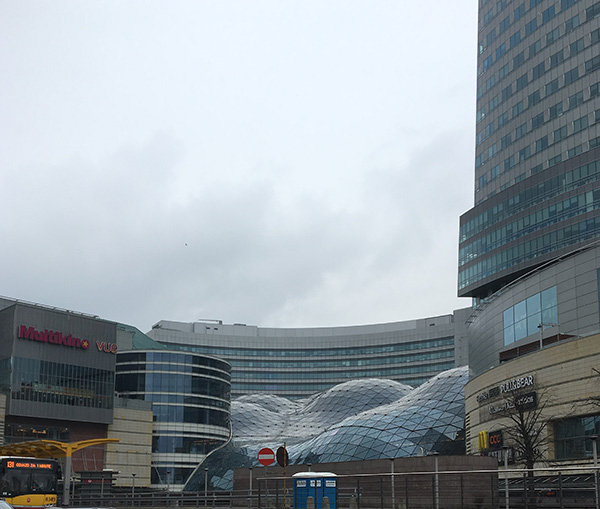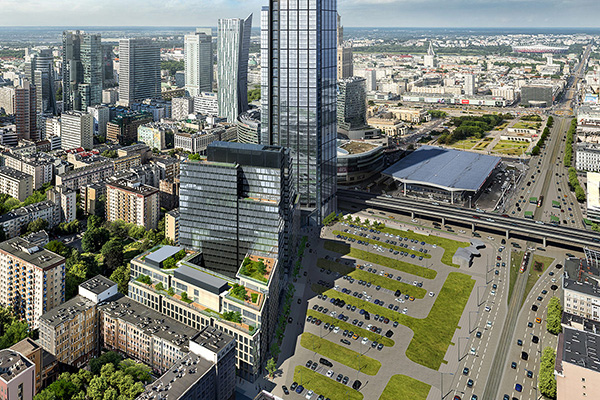
The Palace of Culture and Science, Warsaw, Poland. Photo by Claudia Marina.
Over spring break, I, along with nine other students from Parsons School of Design and The New School for Social Research, had the opportunity to take part in an intensive course offered in Warsaw, which centered around the Palace of Culture and Science. If you’re reading this, you may have read Susan Yelavich’s post “Hacking Warsaw’s Palace of Culture,” which detailed the culminating group projects that resulted from the week’s hybrid seminar-studio class format. This intensive had particular emphasis on the intense if only because of the unique dynamic of the Palace of Culture. Infamously conceived as Stalin’s “gift” to Warsaw, we were told to consider the power at play when architecture is given as a gift without allowing its recipient to reciprocate similarly. In the weeks before flying out to Warsaw, we read several essays about, and examined numerous historic and contemporary images of, the Palace. (Especially important was Michał Murawski’s book The Palace Complex.) They reminded us non-Varsovians of the Palace’s domineering presence, both physical and metaphorical. So it was a surprise to me when I actually got there on a gray afternoon and stood across the street from the Palace at the modern shopping mall, Złote Tarasy, and thought…that’s it?

View of Złote Tarasy, the shopping mall across the street to the west of the Palace of Culture and Science. Photo by Claudia Marina.
The Palace today still stands as the tallest building in Warsaw, though not for long. Construction has reportedly already started on the new Varso Tower by Foster + Partners, which is slated for completion by 2020. Possibly in enthusiasm and support for such a feat, Hermanowicz Rewski Architects designed a set of complementary buildings called Varso and Varso II. The local firm’s website features image renderings of the buildings projected onto the central hub of Warsaw with an obfuscated Palace of Culture being swallowed by a surrounding glass landscape.

Varso and Varso II rendering with Palace of Culture in the background. Image courtesy of Hermanowicz Rewski Architects.
What I found most interesting as a tourist was observing and comparing what I heard and read about the Palace beforehand with what I could learn from Varsovians themselves. As Murawski asked in his tour with our group: Are the attempts to deal with the Palace of Culture today effectively undermining or unintentionally underlining the history and hold the building has over the collective memory of Warsaw’s residents?

Palace of Culture and Science everyday visitors. Photo by Claudia Marina.
Standing at Złote Tarasy and at various commercial points surrounding the Palace and its adjacent parade ground Plac Defilad, the noise of the city felt overwhelming. Though no building towered over the Palace, the juxtaposition of socialist realism and the postmodern architecture around it represented Warsaw at this very moment in history, raising a multitude of questions. How does a city exist in the shadow of wounds? Having gone through the brutal destruction of World War II and Hitler’s subjugation, followed by oppression of Stalin and his proxies in the Polish Communist government (PRL), and an in-between period of post-socialism before embracing neo-liberalism today, what identity does a city unique as Warsaw have? Based on its history, does it have the agency to define itself?
After a week studying inside the Palace, going up elevators and exploring spaces I probably shouldn’t have been in (knowing full well that I was on camera), meeting people who worked 9-to-5 jobs in the Palace, and people who regularly had lunch or drinks at one of the many cafés or bars, I’d like to think yes. Most of those who interact with the Palace have memories of taking swimming lessons at the Palace of Youth or seeing the Electric Glass Lady at the Museum of Technology. Some people are upset at the changes the Palace is undertaking, eagerly talking to anyone about the history of its spaces, showing visitors hand-written records of inventory logs, or working without pay such as in the aforementioned Museum of Technology, which was on the edge of closing during our visit. At the end of the day, there is a strange socio-spatial dynamic, but the Palace doesn’t seem to have been romanticized by Varsovians.
Visitors, local and otherwise, walk out into the city and feed seamlessly into the crowds at the metro or the mall. As much as the Palace’s destruction has been famously fantasized, its reality is embedded in the relationship between architecture and the everyday. As a piece of Warsaw’s contemporary built environment, it reflects history, memory, and tradition. In the past, the pain of war-damaged Warsaw could only be healed by rebuilding parts of it to its former state. (For example, the renaissance market square, called Old Town.) Perhaps this is understood on a subconscious level by the people who walk in, through, or around the Palace. Some days they might hate it, some days they might love it, and some days the Palace is thought of less as “Architecture” than as just a movie theatre.
—Claudia Marina
Tags: intensive course, palace of culture and science, spring 2017, warsaw